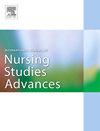Working time distribution and administrative burden in Austrian community health nursing: A cross-sectional survey
IF 3.1
Q1 NURSING
International Journal of Nursing Studies Advances
Pub Date : 2025-07-06
DOI:10.1016/j.ijnsa.2025.100375
引用次数: 0
Abstract
Background
Community health nursing was introduced in Austria in 2022. As the 117 pilot projects now transition into centrally managed services, data on nurses’ working time distribution and client contact patterns are essential for workforce and location planning to ensure optimal service delivery.
Objective
To analyse the working time distribution and client contact patterns of Austrian community health nurses during the pilot phase (2022–2024).
Design
Cross-sectional survey.
Setting(s)
An online survey (April to June 2023) among community health nurses captured their working time distribution and client contact patterns.
Participants
Out of the N = 220 eligible community health nurses, 121 (55%) nurses answered the questions relevant to working time analysis and 115 (52%) for studying regional disparity of service delivery.
Methods
The analysis used descriptive statistics, statistical tests, and regression analysis, employing Excel®, Stata® and R.
Results
Our analysis shows that 92% of the community health nurses in Austria work in non-urban areas. On average, they have one client contact every five working hours, lasting around 75 minutes. Seventy per cent of these encounters result in follow-ups, usually within ten days. Across all regions, 28% of the Austrian community health nurses’ working time is dedicated to home visits and in-office consultations, 7% to outreach efforts aimed at attracting new clients, and 6% to travelling. Further, 29% of time is spent on administration and project management, 8% on team meetings, and 20% on networking and public relations. Service delivery varies significantly by region: rural nurses report fewer consultation hours and more time spent on travelling. Regardless of geography, the time spent on organisational tasks increases disproportionately—and more than any other activity—as total working hours increase.
Conclusions
Each hour spent with a client requires an hour of administration, with no observable efficiency gains in administrative tasks as working hours increase. These findings highlight the need to explore whether targeted organisational support, such as administrative assistance or digital documentation tools, may improve efficiency. Additionally, current restrictions on client outreach and age eligibility may unnecessarily hinder service effectiveness and accessibility.
Tweetable abstract
Study of Austrian community health nurses reveals: for every hour with clients, nurses spend an equal hour on administration. Administrative burden grows disproportionately with longer working hours, with no efficiency gains.
奥地利社区卫生护理的工作时间分布和行政负担:一项横断面调查
奥地利于2022年引入了社区卫生护理。随着117个试点项目现在转变为集中管理的服务,关于护士工作时间分布和客户联系模式的数据对于人力和地点规划至关重要,以确保提供最佳服务。目的分析奥地利社区卫生护士在试点阶段(2022-2024年)的工作时间分布和客户接触模式。设计:横断面调查设置:对社区卫生护士进行在线调查(2023年4月至6月),了解他们的工作时间分布和客户接触模式。在220名符合条件的社区卫生护士中,121名(55%)护士回答了与工作时间分析相关的问题,115名(52%)护士回答了研究服务提供的地区差异的问题。方法采用描述性统计、统计检验和回归分析,采用Excel®、Stata®和r .软件进行分析。结果分析显示,奥地利92%的社区卫生护士在非城市地区工作。平均而言,他们每5个工作小时与客户接触一次,持续时间约为75分钟。这些接触中有70%的结果是后续行动,通常在十天内进行。在所有地区,奥地利社区卫生护士28%的工作时间用于家访和办公室咨询,7%用于吸引新客户的外展工作,6%用于旅行。此外,29%的时间花在行政和项目管理上,8%花在团队会议上,20%花在网络和公共关系上。不同地区提供的服务差异很大:农村护士报告的咨询时间较短,出差时间较多。不管地理位置如何,随着总工作时间的增加,花在组织任务上的时间不成比例地增加——比任何其他活动都要多。结论与客户相处的每一个小时需要一个小时的管理,随着工作时间的增加,管理任务的效率没有明显的提高。这些发现强调有必要探索有针对性的组织支持,如行政协助或数字文档工具,是否可以提高效率。此外,目前对客户外联和年龄资格的限制可能会不必要地阻碍服务的有效性和可及性。摘要对奥地利社区卫生护士的研究表明:护士与客户相处的每一个小时,在行政管理上花费的时间是相等的。随着工作时间的延长,行政负担不成比例地增加,而效率却没有提高。
本文章由计算机程序翻译,如有差异,请以英文原文为准。
求助全文
约1分钟内获得全文
求助全文
来源期刊

International Journal of Nursing Studies Advances
Nursing-General Nursing
CiteScore
5.80
自引率
0.00%
发文量
45
审稿时长
81 days
 求助内容:
求助内容: 应助结果提醒方式:
应助结果提醒方式:


